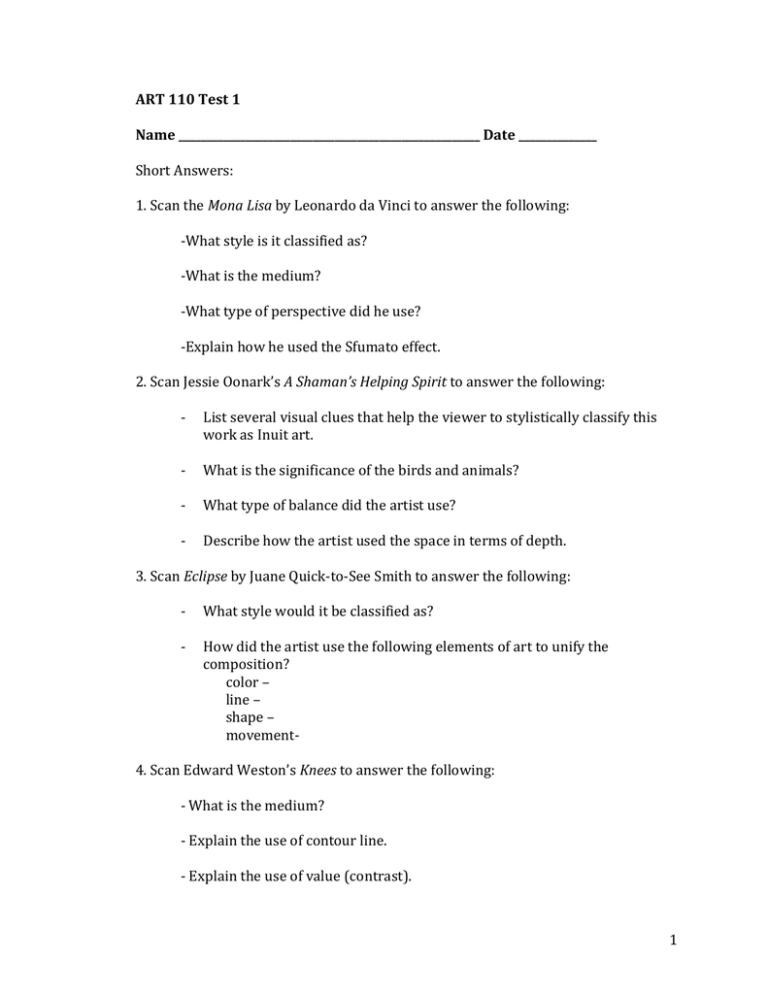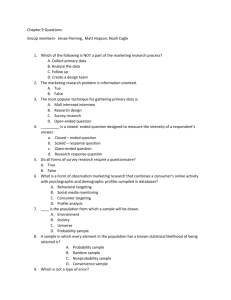ART 110 Test 1 Name Date Short Answers: 1. Scan the Mona Lisa
advertisement

ART 110 Test 1 Name ______________________________________________________ Date ______________ Short Answers: 1. Scan the Mona Lisa by Leonardo da Vinci to answer the following: -What style is it classified as? -What is the medium? -What type of perspective did he use? -Explain how he used the Sfumato effect. 2. Scan Jessie Oonark’s A Shaman’s Helping Spirit to answer the following: - List several visual clues that help the viewer to stylistically classify this work as Inuit art. - What is the significance of the birds and animals? - What type of balance did the artist use? - Describe how the artist used the space in terms of depth. 3. Scan Eclipse by Juane Quick-to-See Smith to answer the following: - What style would it be classified as? - How did the artist use the following elements of art to unify the composition? color – line – shape – movement- 4. Scan Edward Weston’s Knees to answer the following: - What is the medium? - Explain the use of contour line. - Explain the use of value (contrast). 1 - Explain the use of cropping. 5. Scan Elizabeth Catlett’s Sharecropper to answer the following: - What element of art was used to create the depth and texture? - Explain how the hatching technique was used to create dimension in the work? - What did the artist do to define the contours in the work? 6. In the space below draw an example of the following: -Organic shape: -Geometric shape: 7. In the space below draw an example of the following: - Rectilinear shape -Curvilinear shape: 8. Scan Frank Gehry’s Guggenheim Museum, Bilbao, Spain and answer the following: - What category of the art does it belong to? - What are the predominant shapes used in the design of the building? 9. Scan the Rubin vase image and explain the following concepts that are present in the image: - The positive/negative: - The figure/ground reversal: 10. Scan Pierre-Paul Prud’hon’s La Source and explain how the artist used the chiaroscuro technique to achieve the value effects: 11. Explain the difference between the following: -Additive color: -Subtractive color: 2 12. List the three primary colors and explain why they are the primaries: 13. List the secondary colors and how they are formed: 14. Give an example of a tertiary color: 15. What hue is the complement of red on the color wheel? 16. Give an example of a hue from the warm side of the color wheel: 17. Give an example of a hue from the cool side of the color wheel: 18. What does it mean when a painting is said to have a monochromatic color scheme? 19. Where would find Analogous colors on the color wheel? 20. Explain the difference between the following: -Local color: -Optical color: 21. Explain how Vincent Van Gogh used the following in his paintings: -Impasto: -Texture (Specific type of): 22. What does the term trompe l’ oeil mean in relationship to 2D art works? 23. Scan Frederic Edwin Churches Andes of Ecuador to answer the following: -Explain the use of atmospheric perspective: -Explain how the artist directs the viewer through the picture starting from the foreground to the middle ground to the background: 24. Scan Dali Atomicus by Phillipe Halsman and explain the following concepts: -The photographic technique of Freeze motion that is evident: 3 -Is it a good example of actual motion or implied motion? 25. Scan Archibald J. Motley Jr.’s Saturday Night to answer the following: -What is the predominant element of art that the artist used to unify the work? -What principle of art does he use to direct the viewer through the painting? 26. What does it mean when a composition is symmetrically balanced? 27. How does the United States Capitol Building fit the principles of formal balance and bilateral symmetry? 28. Scan Lucas II by Chuck Close and explain how he used the concepts of -Radial design: -Focal point: 29. The principle of art that uses the regular repetition or orderly progression of a shape or pattern is called? 30. This principle of art refers to size relationships such as small, big, or in between? 31.The distinctive handling of elements and media associated with the work of an individual artist, school, or movement is known as? 32. The portrayal of people and things as they are seen by the eye or really thought to be is known as? 33. Art that departs significantly from the actual appearance of things and makes no reference to nature or reality is known as? 34. Scan Grant Wood’s American Gothic and explain the following concepts’ - Why does it belong to the Regionalism movement or school? - Why does it belong to the Representational category? - What type of balance did the artist use? - How did the artist use repetition? 4





